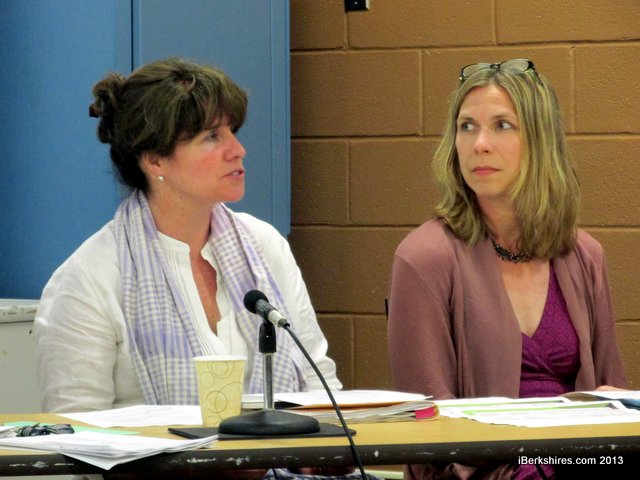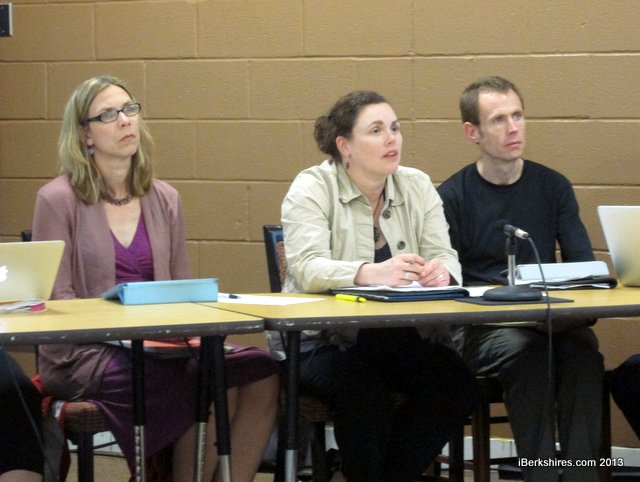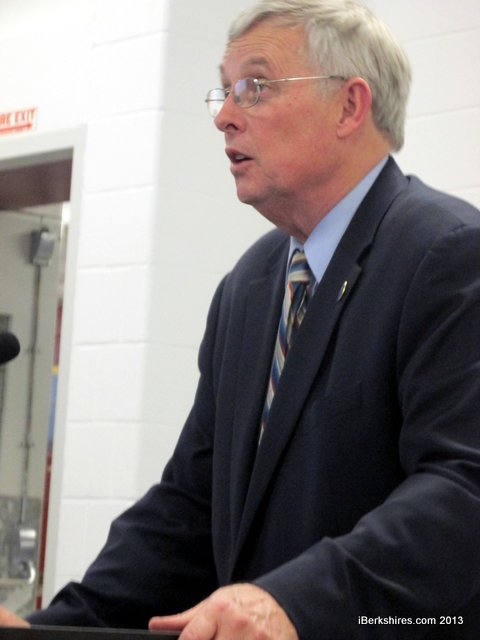Mt. Greylock Regionalization Group Taking Case to Community
 Mary MacDonald, left, makes a point at Thursday's meeting of the regionalization committee. Mary MacDonald, left, makes a point at Thursday's meeting of the regionalization committee. |
WILLIAMSTOWN, Mass. — The committee charged with studying an expansion of the Mount Greylock Regional School District has an expansive schedule of its own over the next few weeks.
The Regional District Agreement Committee met recently at the junior-senior high school to talk about what it has learned and what it plans to say about regionalization in a series of meetings with teachers and community members.
The RDAC, which met for the first time in late February, is looking at an ambitious timeline that could as soon as this fall ask voters whether to bring the Williamstown and Lanesborough elementary schools into the regional district.
For the last three months, the 15-member committee's working groups have been studying various aspects of potential expansion, including the impacts on finances and education, how the regional expansion itself would be worded and the public relations campaign needed to convince voters of the benefits of expansion.
The goal is to create a prekindergarten-through-12 district that includes the elementary schools from the two towns that already compose the Mount Greylock district.
"It's staggering how much stuff we put together on this project," Stephen Hemman of the Westminster-based Massachusetts Association of Regional Schools, which was hired with the proceeds of a state grant to advise the RDAC, told the committee on Thursday.
"The grant ends June 30. ... If the Mount Greylock committee decides in your favor, you're probably talking September or October to go to the communities with a special meeting or you can wait until the spring.
"Before you go to town meeting, you want to go out to the people and explain."
That effort kicks into high gear on Monday, June 3, when the RDAC meets with the faculty of Williamstown Elementary School. Two days later, it will meet with the faculty at Mount Greylock, and the next night, it will meet with the Lanesborough Elementary School teachers. On June 18 and 19, the RDAC will hold back-to-back community forums: Tuesday at the high school and Wednesday at LES.
One question the committee is likely to face: How would greater regionalization affect taxes?
To answer that question, the committee's finance working group ran a simulation of the fiscal 2013 budgeting year to compare the actual assessment in each town to what its assessment would have been under a PK-12 model.
The bottom line was that regionalization would have lowered the aggregate cost of education in the two towns by about $173,000, largely because of an increase in transportation reimbursement offered by the commonwealth to regionalized districts.
But the savings would not have been spread evenly between the two towns.
Because school taxes largely are determined by a state formula based on the community's ability to pay, Williamstown taxpayers would have ended up with a 2.3 percent increase in their total PK-12 assessment for FY2013.
In the current fiscal year, Williamstown voters are paying a total school appropriation of $9.1 million ($4.5 million for the elementary school and $4.6 million to Mount Greylock). Under the simulation, the town's total assessment to a PK-12 Mount Greylock Regional School District would have been $9.3 million, a difference of $208,126.
 Regional District Amendment Committee members, from left, Tricia Bitteker, Margaret McComish and Dan Caplinger. Regional District Amendment Committee members, from left, Tricia Bitteker, Margaret McComish and Dan Caplinger. |
On the other hand, Lanesborough would have paid $380,754 less in FY13 to a PK-12 district. Its actual tax bill to the two districts this year is $5.3 million ($2.8 million for LES and $2.5 million to Mount Greylock). In the simulation, Lanesborough's total assessment would have been about $4.9 million.
Hemman's staff noted that the actual tax impact on Williamstown could be lower in the near term. The simulation was run on the assumption that all teachers in the PK-12 district would have been paid using the salary schedule at Mount Greylock, which is higher than the salary schedule at the elementary schools.
"For Williamstown, you're looking at the worst-case scenario," Paul Gagliarducci of MARS said. "That $208,000 can get better depending on how the salaries are negotiated."
Russell Dupere, the committee's legal consultant, said the district likely would phase in the pay increases over time. There are differences between the three existing teacher contracts that would need to be reconciled if and when all the teachers are working for the same district, Gagliarducci said; health insurance, the length of the work day and severance packages are examples of terms that differ among the three current districts.
"How do we know at this stage if any of this is going to be a deal-breaker in negotiation?" RDAC Chairwoman Carolyn Greene asked. "Have you had a situation where towns have voted to have a region and they couldn't negotiate a contract?"
"The region doesn't fall apart over the collective bargaining agreement," Gagliarducci said. "You continue to work with what you have. ... You could maintain the current contracts on a temporary basis. You can maintain the current contract with gradual consolidation. You can grandfather certain people. You can negotiate a single contract.
"There's a hundred different ways to make this happen."
Of course, not all of the issues surrounding an expansion of the district deal with money.
 Stephen Hemman of the Massachusetts Association of Regional Schools. Stephen Hemman of the Massachusetts Association of Regional Schools. |
The RDAC also has been looking at how such a change would impact the education of the towns' students.
The administrator who spent the last year coordinating curriculum, instruction and assessment among the three schools said that such coordination would be improved if all three are part of the same district.
"[Now] there's no regional authority to say, 'Let's do this,'" said Mary MacDonald, who next year will serve as the principal of Mount Greylock. "Aligning the curriculum is about negotiation."
Mount Greylock teacher Lyndon Moors agreed that an expanded district would spur cooperation among the faculties at the three schools.
"I see it as an ownership issue," Moors said. "As a K-12 organization, you feel these are all your students."
Moors joined MacDonald, LES teacher Stacy Parsons, WES teacher Tricia Bitteker and Tri-District Superintendent Rose Ellis on RDAC's education working group.
Ellis pointed out Thursday that regionalization would facilitate mentoring and coaching of teachers, and it would allow for more professional development opportunities that bring together teachers from all three schools since all would be on the same academic calendar.
RDAC member Dan Caplinger, who serves on the Williamstown Elementary School Committee asked if there was any downside to regionalization from an education standpoint. MacDonald said there have been questions raised about whether individual elementary schools would have to give up special programs if they are not replicated at the other school, but she believed such programs could be maintained.
"The district would have to provide basic education, but each school can have its own little thing," Hemman said.
Tags: MGRHS, regionalization, school committee,















